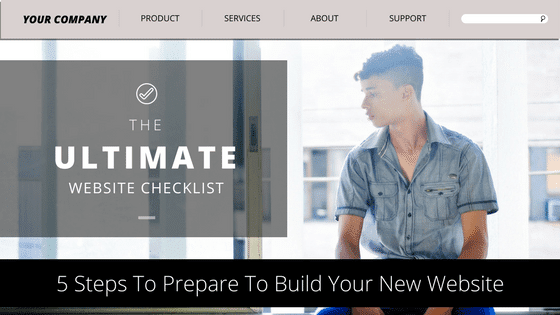Does your website have what you need to earn clients through it?
Will it even help you do business?
If you haven’t checked in to see what your website needs, you may be missing out on better results.
Don’t feel bad, though.
Many small business owners don’t know whether their website is performing to its fullest.
Heck, a third of small businesses don’t even have a website.
It’s a big problem, especially if you expect to take advantage of the massive audience that the internet provides.
Part of making sure your website works for you is knowing what it’s supposed to have to live up to its full potential.
Fundamentals are everything.
So, let’s find out what your website is supposed to have.
Contents
Does Your Website Have The Traffic It Should?
I know you’re eager to find out if your website has what it’s supposed to have.
But hold on a second.
Your website can’t have success if you don’t drive people to it.
So, even though your website may be underperforming because of what it doesn’t have, you won’t know if you’re not getting traffic.
Traffic that you can’t get without a good digital marketing strategy.
If you already have a website, you ought to check on your traffic first.
Don’t ask what your website should have if it doesn’t have traffic. Click To TweetBe certain you’re doing all the things you should be to get more people to your site.
Think about it.
Does your website have a digital marketing strategy to go with it?
Without this in place, you don’t get traffic, and without traffic, the best possible website can’t do anything for you.
What your website has or is supposed to have are irrelevant.
The features your website should have matter for conversion only.
You can’t convert without traffic.
Does Your Website Have What It Needs?
So, the reality is that websites have certain needs if you want them to convert leads.
These needs are aside from the obvious lead funnel.
People need to find certain things on your site if they’re going to begin to trust you.
It’s the information that matters to anyone considering working with a brand.
Sections, information, and features that prove your company is worthy of their trust.
Without these critical bits of information, your website visitors will likely leave without converting.
They’re that important.
However, they’re also simple to assemble and make sure they’re something your website does have.
And, of course, after you find out what they are you’ll realize their importance.
Let’s find out what they are, shall we?
Your Website Should Have A Clear Description Of Your Brand
When people arrive at your website, it should have clear communication of who you are.
Honestly, people who go to your website want to learn about your company.
They’re interested to find out about the brand behind the product or service they’re considering or about the company behind the content.
Part of choosing a product or service is understanding the company that offers it.
Customers want to know if that company backs causes that matter to them, what motivates them to be in business, and whether they can be trusted.
Their opinion of your brand will be formed based on the information the pages on your website have.
So, what do you think happens if you don’t tell them who your brand is?
You need to make sure there is a section of content on your website – either as its own page or as a section on the home page – that identifies the important details of your company.
- When were you founded?
- What caused you to choose your industry?
- Why were you motivated about this product?
- Where are you based and where do you serve?
- How did the idea for your company come about?
Including the answers to the most important questions will help you build trust and earn leads.
Your Products Or Services Should Be Clearly Listed
What do you do?
Are you a service provider that caters to a certain need in a certain industry, or are you a product provider with wares that serve many needs?
You have to communicate how you can help people.
Second to information about who you are, people look for information about what you do when they come to your website.
They want to know if the products or services you offer reflect what they’re looking to achieve.
Ultimately, they’re looking to see if your offering is a fit.
For them to do that successfully, you need to list your products or services on your website.
Your website must have a section that explains what you offer and what it does for your potential clients.
If you sell retail products, an e-commerce solution makes the most sense.
For B2B product providers or those whose products are high-ticket items, a catalog might make more sense.
Brands that provide a service need to make sure they explain what that service entails.
Make it clear to your website visitors that what you have to offer is what they’re looking for.
When the pages of your website have a clear outline of your offerings, you’re far more likely to convert those visitors to clients.
Your Website Needs A Friendly Layout And Design
Websites that are difficult to use have a hard time keeping people on them.
In fact, with the right layout and design, you could help your website have 400x the conversions.
That’s what makes a website’s layout and design so critical.
As you develop your layout and design (or work on it with a developer), make sure you test to find out the simplest way to use your website.
The fewer problems your website users have, the more likely they are to stay on your site.
If they’re staying on your site longer, they improve your SEO score and the odds that they’ll choose to work with you go up.
Reason being trust is built over time.
While they spend more time on your site, they find more reasons to trust you.
They find all the content that proves you know what you’re talking about.
People want to know the company they choose to work with is knowledgeable and can help solve their issues.
But they can only find out what you know and what you’re capable of if the user interface on your website allows them to.
Do the functions and layout of your website have any hiccups or pain points that might deter people from continuing?
Those kinds of issues will only lead to lost traffic.
However, if you correct it, you can build leads much more effectively.
Your Contact Information Should Be Easy To Find
People who come to your website have a desire to find out about your company.
Sometimes they have a question that your website just can’t answer.
Maybe it’s because the question isn’t a common one that you get.
Perhaps it’s something incredibly specific to their situation.
When that occurs, what do you expect them to do?
Visitors with complex or unusual questions should be able to contact you and ask.
But will they be able to find the simplest way to communicate with you?
Unfortunately, too many small businesses don’t have a simple way for people to get in touch with them through their website.
That seems silly to me, though, because there are so many options available.
From listing basic contact details, like a phone number, email address, and mailing address, to adding a basic contact form, to adding live chat, there’s no reason not to include a way to contact you.
Many of the options are easy to add to your website as well.
Rather than fail to make the information on your website have your contact info, make it easy to get in touch with your company.
Learn how much difference that direct access makes for your success.
Your Website Should Have Social Proof
People who visit your website are looking for reasons to trust you.
When they get there, they will either find reasons or find a reason not to.
That’s why social proof is something your website should have.
Social proof is a simple concept.
It’s a collection of comments that come from your customers talking about their experience working with you.
They can come in many formats, including:
- Reviews
- Ratings
- Case Studies
- Testimonials
Content like this has a psychological effect on your audience.
A person facing a decision is more likely to make that decision if others have made it with success.
If people can’t determine the right mode of behavior, they turn others into experts by assuming those people know what they’re doing.
Then they copy the behavior.
Your job is to present the positive results of others who have chosen to work with you.
That allows your website to help influence the decision-making process for prospective buyers, swaying their decision in your direction.
Improved odds mean you’ll have more website visitors convert to leads, and eventually, sales.
Your Call-To-Action Should Be Obvious
Why do you want visitors on your site?
Obviously, over the long term, it’s to make them into customers.
So, how does that process begin?
Right there, at the most obvious and logical place on your website, should be an instruction, telling your audience the first step in becoming your client.
A call-to-action is a signpost for your website visitors that tells them what you want them to do next.
And there should be an obvious one on every page of your website.
Chances are your audience won’t do what you want them to unless you tell them what that is.
Your CTA should take your visitor to the next logical step, be that newsletter signup (so they can be nurtured towards buying) or contacting you for a quote.
The driving idea behind a CTA is to bring the website visitor to the process, meeting them in whatever phase they are at to get them on course for the next phase.
It’s a basic concept.
These can be buttons or forms that they can use to obtain some benefit that helps them in the phase of the buying cycle they are in.
By using an effective, tested CTA, you can guarantee that a higher percentage of your audience will step into the next phase of the journey.
You Must Have A Blog
Content is everything when it comes to things you should have on your website.
It’s the core of SEO, content marketing, and lead nurturing.
Through a blog, you can build massive website traffic and demonstrate enough value to earn leads.
Google will use it to send potential clients your way.
Most importantly, you can use it to move people from browsing visitors to happy owners of your product.
Without a blog, however, it’s unlikely you’ll see any significant traffic.
You’ll also have more trouble qualifying your visitors before they become leads.
And that might be the most powerful point of a blog.
Does your website have the information that people preparing to buy your product are looking for?
Blogs give that to you.
Problems that people are looking to solve get searched for on Google.
If your website has the answers to those questions, they’ll find you.
Including those answers within frequent, scheduled blog content allows that to happen.
All those answers eventually lead to buying from you.
Does Your Website Have What It Should?
Now that you know what your website should have, you can make sure it does.
If that requires you to rebuild, tackle it quickly.
But most adjustments shouldn’t.
Usually, these are all adjustments you can make without too much trouble.
Once you do, you can see the difference it makes when you see your website have what it needs added.





